
info@synthesys.co.uk • +44 (0) 1947 821464
OptimiSE Magazine
OptimiSE magazine is a SyntheSys Technologies’ publication aimed at members of the engineering, systems and software development community. The magazine aims to share best practices and technical insight and gives us a platform to share company news. This informative magazine presents a collection of articles about Systems and Software and we hope that you, our colleagues and customers throughout the community, will find it both interesting and useful.
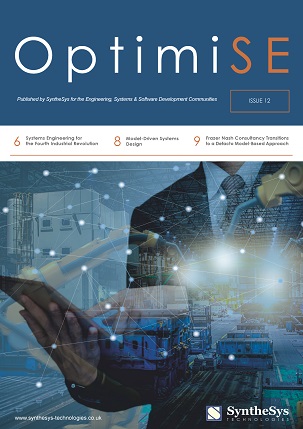
Featured Issue – Exploring Model-Based Systems Engineering and the Next Era of Engineering & Manufacturing

Systems Engineering for the Fourth Industrial Revolution
In the era of Industry 4.0, where the convergence of digital technologies and physical processes is transforming the landscape of manufacturing and production, systems engineering emerges as a critical player in orchestrating the seamless integration of complex systems.
Issue 12
Model-Based Systems Engineering (MBSE) – A Fitness Plan
MBSE is about developing, verifying and validating system design requirements, using diagrams and can allow a business to produce a digital prototype of a system or process being developed. This article explores the merits and uses of this growing development approach.

Issue 12

Frazer-Nash Consultancy Transitions to Defacto Model-Based Approach
An industry story which outlines how Frazer-Nash Consultancy have ‘left-shifted’ development as supported by IBM® Rhapsody®. As a long-standing business partner to Frazer-Nash Consultancy, SyntheSys Technologies was tasked with supporting the Frazer-Nash team through this transition.
Issue 12
More from OptimiSE Magazine

Transforming the Product Lifecycle through Digital Engineering
This issue is themed around Tool-Supported Systems Engineering, as facilitated by the IBM® Engineering Lifecycle Management (ELM) suite. It’s no coincidence that we published this magazine in line with our IBM® ELM Future Forward User Day, which takes place on 15th June at the IBM® Innovation Centre in London.

Improve Competitiveness through Systems Engineering Training
“There is a strong direct relationship between past experience and the likely success of future projects.”
This is one of the conclusions from a Carnegie Mellon® survey on the effectiveness of systems engineering, but it confirms what many people know intuitively.
This article looks at a research piece carried out on projects identified with the aid of The United States’ National Defence Industrial Association (NDIA), the Institute of Electrical and Electronic Engineers (IEEE), and the International Council On Systems Engineering (INCOSE).

Engineering the ‘Net’ in ‘Net Zero’
This article explores Carbon Capture and Storage (CCS) infrastructure programmes as a means of decarbonising industrial clusters. Deploying larger CCS systems – on the scale of an entire industrial park or a city – may mitigate financial and political risk, but will bring with it a new set of engineering challenges.
Subscribe for free to receive OptimiSE Magazine.
Or maybe you would like us to send you and your team a free hard copy of the magazine?
Email us at info@synthesys.co.uk to let us know.


Renewable Energy Meets Engineering Workflow Management
The green agenda is at the heart of many organisations and this shift towards renewable energy brings untold amounts of engineering complexity. This article explores the role that ‘Tool-Supported Systems Engineering’ is playing across the Energy market, with an emphasis on our latest customer commission.
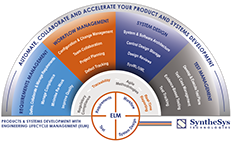
IBM® Engineering Lifecycle Management (ELM)
To cope with rising product complexity and significant amounts of data, modern engineering teams must improve existing methods of working whilst embracing new processes and technologies to maintain a competitive edge. This feature explores how the ELM suite is working hard for Engineering in high-growth sectors.

SyntheSys STEAM Challenge
SyntheSys Sponsors this year’s ‘STEAM Challenge’ with local school after a two-year hiatus due to the pandemic.

Integrated Rail Engineering: Engineering and the Williams-Shapps Plan
With an accelerated transition to requirements being driven from the centre, suppliers will accordingly need to step up their transition to a more integrated approach to engineering. This article explores how systems engineering can support rail infrastructure reform.

Model-Based Testing in Defence
It’s well known that testing of military platforms is high cost, particularly when testing the integration and interoperability of platforms in a live environment. This article looks at the merits of using modelling to understand system components.
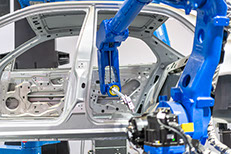
Optimised Automotive Manufacturing
The automotive industry invented Lean manufacturing, and with the advent of technologies for digital and green manufacturing, supply chain integration and transparency, and more widespread automation of the manufacturing process, automotive continues to be a vanguard of clean and heavily optimised product value streams. This article explores systems engineering in the context of Lean manufacturing and fast-paced automotive innovation.

Meet the Team: Matt Hirschfield
During an exciting time of growth, SyntheSys Technologies is thrilled to welcome Matt Hirschfield to the technical team. Matt joins us as a Principal Engineer and brings depth of knowledge around our IBM® Engineering Lifecycle Management portfolio offering.

Maximising Customer Value in Automotive Engineering
There's a delicate balancing act to be struck in contemporary automotive engineering. This technical article explores how specialist automotive manufacturers can better understand, prioritise and address customer requirements through the use of systems engineering practices.

Automotive Engineering Management & Compliance with IBM®
We live in an age of constant technological change, and automotive engineers build some of the most complex assets on the planet. Our solution tour explores how engineers can leverage the power of IBM® Engineering Lifecycle Management (ELM) suite for Automotive; a solution specifically designed for the complex and evolving needs of the Automotive industry.
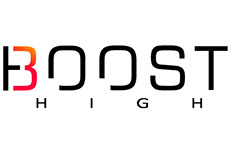
New Technology Partner: BoostHigh
In an exciting time of change and growth, we are pleased to announce our latest strategic alliance with Poland-based software development company, BoostHigh.

Agile Systems Engineering
Many industries have now reached the threshold of complexity past which traditional methods of project management are no longer up to the task, but aerospace and defence was the first, and systems engineering was the result. This article explores how Agile and Systems Engineering can be combined to better manage complex system development programmes.

Speedy Success for Porter Sports Racing
The UK automotive industry is a vital part of the UK economy worth more than £82 billion turnover and adding £18.6 billion value to the UK economy. SyntheSys has been providing engineering services to the automotive industry for several years which is why we were thrilled to hear of an interesting and unique opportunity to get involved with local motor car racing team, Porter Sport Racing, via an exciting sponsorship arrangement.

The Complexity Gap
Managing complexity in rail supply using proven systems engineering methods. Even before the COVID-19 crisis, the next few years looked like a period of significant change for the rail industry. The network is being transformed by massive investment in the digital railway, and technologies like cab signalling and condition-based maintenance require IT integration between systems that never used to directly interact.

Adapting the Product Life Cycle for Complexity
As the pace of change increases, development processes have adapted to a world where requirements can change at any stage of the life cycle, with a strong focus on streamlined development of individual subsystems and iterative testing. This article discusses how having an approach to the life cycle which emphasises the whole system can be critical to success.

Introducing Version 7.0 of Engineering Lifecycle Management
This article explores the new release of the IBM® Engineering Lifecycle Management (ELM) toolset. ELM is a set of integrated tools that work together to offer full traceability across the engineering process.

2020 Systems Engineering Training Course Announcement
We are delighted to announce that we will be delivering the remaining 2020 training courses in line with social distancing requirements.

Engineering Supply Chain Collaboration
Getting suppliers to understand your requirements can be time-consuming and costly through poor communication and misunderstandings. This article examines different automated solutions for effective engineering supply-chain management.
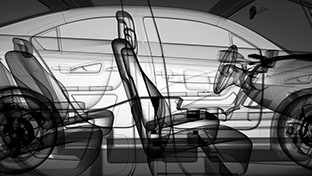
Electrification in the Automotive Industry: A Systems Engineering View
As we take major strides towards complete electrification on our roads, this article considers the development of Electric Vehicles (EVs) and discusses some of the key elements to which systems engineering methodologies and practices can accelerate EV adoption.
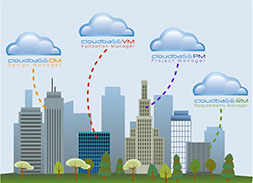
Engineering Development in the Cloud
Many of us use the Cloud without realising it, as it sits behind social media, online shopping and government services that we all use every day. More than ever we use connected devices and the exponentially-growing Internet of Things, but not all businesses are taking full advantage of what the Cloud can do for them. This article considers how Cloud solutions may enhance and accelerate engineering development.

Transport for London (TfL) Success
TfL uses SyntheSys' cloudbaSE SaaS facility to flexibly manage Systems Engineering Tools.

Improved Productivity through Collaborative Engineering Management
Improved competitiveness through Collaborative Engineering Management.

Guest Article: Progressive Assurance for the Rail Industry
This article will take a look at some of the pitfalls that are commonly encountered in the mega rail and metro infrastructure projects.

Functional and Non-Functional Requirements
Functional Requirements describe how a product must behave - they identify its functions. Some people describe these as 'capability' requirements. These are the ones that everyone has an opinion on and they are relatively easy to capture.
Non-Functional Requirements are sometimes described as 'anything about a system that isn't what it does'. They describe the quality attributes of a system and they impose limitations on the functions of the system.
In this article we look at the difference between functional and non-functional requirements. What's the difference between what the solution must do and how it must be done?

Guest Article: Model-Based Systems Engineering with OMG SysML™
Model-Based Systems Engineering is a growing discipline within Systems Engineering that returns significant benefits over traditional document-based methods across the entire life cycle.
Guest author, Fraser Chadburn, discusses the merits of the techniques and how OMG SysML™ is a game changer.

Supporting Network Rail IT Upgrade
SyntheSys completes an upgrade of IBM® DOORS® and Rational® Publishing Engine at Network Rail.
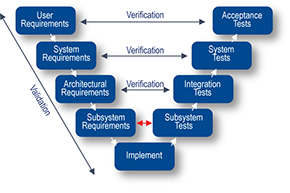
What is the purpose of
Verification and Validation?
Our Systems Engineering trainer, Mark Williamson, gives his top tips for effective Verification and Validation.
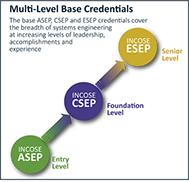
Getting Certified
As a Systems Engineer, are your capabilities recognised and does it matter? Exploring certification.
Site Map
Corporate
About us
Careers
Contact us
Cookie Policy
Legal
Memberships and Accreditations
Our Approach
Our Customers
Our Events
Our People
Privacy Statement
Technology Partners
Working with Us
© SyntheSys Systems Engineers Limited - All Rights Reserved
Version 2.0q dated 11 March 2024